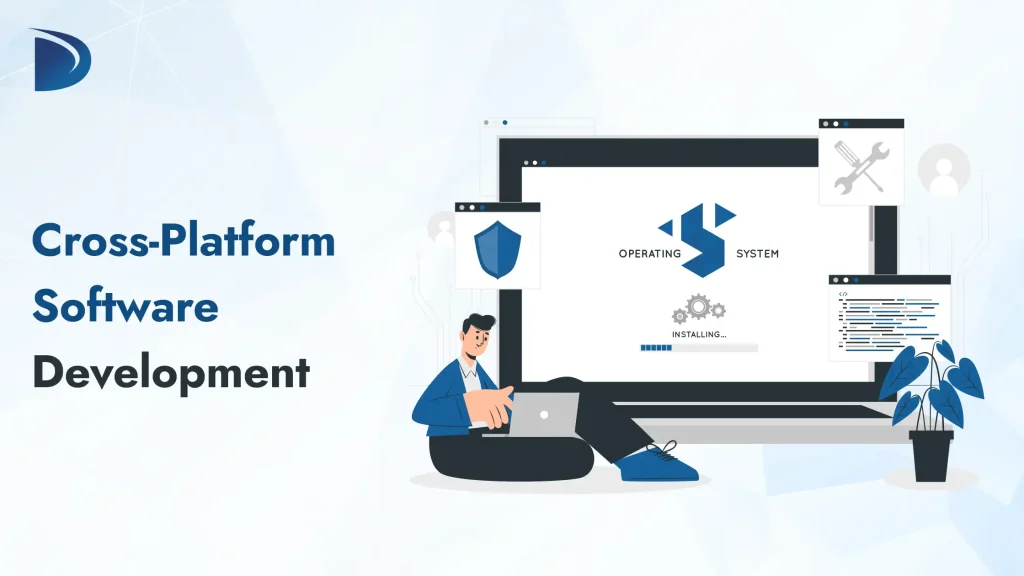Table of Contents
Ever felt like app development takes too long and drains your budget? You create one version, then rebuild it for every platform. It slows everything down and adds more work than needed. That’s where Cross-Platform Software Development makes a real difference.
You write one codebase and use it across Android, iOS, desktop, and more. It simplifies the process while maintaining a consistent user experience. In this blog, we’ll break down how it works, explore popular tools, and look at when it’s the right choice for your next project.
“Over 50% of apps built today use a cross-platform approach to save time and costs.“
(Source: Statista 2024)
What is Cross-Platform Software Development?
Cross-platform software development involves creating a single software solution that runs on multiple platforms, including Android, iOS, Windows, and macOS. Instead of building each version from scratch, developers use shared tools and code that work across all systems.
The real strength lies in using a single codebase. This core set of files holds the app’s main logic, design, and features. Changes made to it are reflected across every platform, reducing extra work and maintaining consistency.
This approach enables faster, more cost-effective, and easier-to-manage development in the long run. It helps teams avoid repeating tasks and enables them to focus on improving a single solution that runs everywhere.
So, how does Cross-Platform Software Development work?
You don’t need to build the same software repeatedly for each device. Cross-platform development makes it possible to build once and run it anywhere.
1. One codebase for all platforms
Instead of writing separate code for Windows, macOS, Android, iOS, or the web, developers use one shared codebase. It saves time and keeps everything easier to update.
2. Choose the proper framework
Frameworks like Flutter, React Native, Electron, Xamarin, or .NET MAUI enable your code to connect to various platforms. Each one fits different use cases. Some work better for mobile apps, while others are suited for desktop or mixed-platform needs.
3. Add platform-specific tweaks if needed
Most of the app can remain the same, but occasionally, small parts require special treatment. A camera feature might work differently on a phone than on a laptop. You can adjust just those parts without changing the whole project.
4. Abstraction layers do the heavy lifting
Behind the scenes, your code passes through a runtime or bridge. This layer enables the shared code to integrate with each platform’s native features, such as file storage or user interface elements, without requiring separate versions for each one.
5. Final builds and testing
Once your app or software is ready, separate builds are made for each platform. These are tested to check how things look and behave on different devices.
Considering a cross-platform app?
Some Popular Cross-Platform Development Frameworks
A Cross-platform Mobile App Development Company often uses these tools to build a single solution that runs on multiple devices.
i) Flutter
Flutter is an open-source toolkit built by Google. It uses the Dart language and focuses on creating custom, high-performance UIs from a single codebase.
Best for: apps with heavy UI, animations, or custom design
Works on: Android, iOS, web, and desktop
Key strengths:
- Fast rendering with its engine
- Hot reload for quick testing
- Doesn’t rely on native UI components
Drawback: Dart has a smaller developer pool than JavaScript
ii) React Native
React Native, developed by Meta, allows developers to write apps using JavaScript and React. It connects with native components under the hood.
Best for: general-purpose mobile apps where speed to market is important
Works on: Android and iOS
Key strengths:
- Large community and third-party library support
- Shared logic with web (if using React)
- Faster development for teams already using JavaScript
Drawback: May need native modules for advanced device features
iii) Electron
Electron is used to build cross-platform desktop apps using web technologies like HTML, CSS, and JavaScript.
Best for: desktop tools, productivity apps, or chat clients
Works on: Windows, macOS, and Linux
Key strengths:
- One codebase for all major desktop platforms
- Popular apps like Slack and VS Code are built with Electron
- Uses Chromium for consistent rendering
Drawback: Higher memory usage compared to native desktop apps
iv) Xamarin
Microsoft supports Xamarin, enabling developers to build native Android and iOS apps using C#. It’s often used in enterprise apps where .NET is already in place.
Best for: companies using Microsoft tools and looking to share backend logic
Works on: Android and iOS
Key strengths:
- Full access to native APIs through C# bindings
- Strong connection to Visual Studio and Azure
- Reuse of existing .NET business logic
Drawback: UI design flexibility is limited without custom work
v) .NET MAUI
.NET MAUI is the modern version of Xamarin. It enables one project to target both mobile and desktop platforms with a native UI, using a single C# codebase.
Best for: apps that need shared logic across mobile and desktop screens
Works on: Android, iOS, Windows, and macOS
Key strengths:
- Single project structure across all platforms
- Supports native UI controls
- Uses the latest .NET updates for better performance
Drawback: Still growing, so community support and resources are limited
vi) Qt
Qt is a C++ framework used to build performance-driven desktop apps and embedded systems. It’s widely used in industries like automotive and industrial automation.
Best for: high-performance apps in embedded or hardware-focused environments
Works on: Windows, macOS, Linux, and embedded devices
Key strengths:
- Fast UI rendering using its engine
- Supports touch, 3D graphics, and real-time processing
- Firm internationalization and hardware integration
Drawback: Not ideal for mobile or quick-turnaround web apps
Key Advantages of Cross-Platform Software Development
1. Faster Time to Market
A shared codebase means features are built once and launched simultaneously on all platforms.
2. Lower Development Cost
One team and one project reduce the time and budget required for separate apps.
3. Easy Code Reuse
The same logic and design work across devices, reducing repeat tasks and errors.
4. Simple to Update
Fixes and new features are applied to all platforms simultaneously, without requiring additional steps.
5. Consistent Experience
Users receive the same layout, features, and feel, regardless of whether they’re on Android, iOS, or desktop.
6. Smaller Team Needed
You don’t need different teams for each platform, which makes hiring and planning easier.
7. Better for MVPs
For quickly testing an idea, cross-platform solutions save time without compromising core features.
Challenges of Cross-Platform Software Development
While cross-platform tools simplify many parts of software building, they also come with a few trade-offs.
1. Slower Performance
Apps run through extra layers, which can cause speed to drop, especially during animations or other visually intensive tasks.
2. Limited Device Access
Some hardware features, such as sensors or Bluetooth, may require additional setup or may not function fully.
3. UI May Feel Off
One design doesn’t always match how apps look or behave on every platform, causing inconsistency.
4. Harder Bug Tracking
Issues may behave differently on Android and iOS, making it more challenging to identify and resolve problems quickly.
5. Framework Delays
New Android or iOS features may take some time to appear in cross-platform tools and libraries.
6. Tool Learning Curve
Frameworks like Flutter or React Native utilize tools or languages that some teams may not be familiar with.
“80% of performance issues in cross-platform apps come from heavy UI and animations.“
(Source: Developer surveys 2024)
Cross-Platform vs Native Development: What Sets Them Apart?
| Feature | Cross-Platform Development | Native Development |
| Codebase | One codebase for all platforms | Separate codebase for each platform |
| Performance | Slower for complex UI or animations | Matches eachplatform’ss look and feel exactly |
| Access to Native Features | May need extra effort or plugins | Full access to all device features |
| Design Flexibility | Shared UI may not match platform standards | Teams need to know each platform’s tools/languages |
| Time to Launch | Faster with one project | Longer due to separate development paths |
| Team Skill Requirements | One team with shared tech skills | Fixes and updates are handled separately for each platform |
| App Size | Often larger due to extra libraries | Typically smaller and more optimized |
| Tool Dependence | Tied to third-party frameworks and updates | Fully relies on platform SDKs and tools |
| Maintenance | Easier to update across platforms at once | Fixes and updates handled separately for each platform |
| Best Use Case | MVPs, simple to mid-level apps, quicker builds | High-performance, complex apps with custom UX needs |
Conclusion
Cross-platform software development helps reduce extra work by using a single codebase across multiple devices. It supports faster builds, lower cost, and easier updates without needing separate teams for each platform.
It’s not right for every project, but it works well when speed, budget, and shared logic are key considerations. For many businesses, maintaining simplicity and consistency across mobile and desktop platforms is a key approach to innovation.
FAQs
What is cross-platform software development?
Cross-platform software development involves building a single application that runs on multiple platforms, such as Android, iOS, Windows, or macOS, using a shared codebase rather than separate codebases for each platform.
How does cross-platform software development work?
It works by utilizing a single codebase and frameworks such as Flutter, React Native, or Xamarin. These tools connect your code to each platform’s native features through abstraction layers, enabling it to run smoothly on various devices.
What are the main benefits of cross-platform development?
Key benefits include faster time to market, lower development costs, smaller teams, easy updates, and a consistent user experience across platforms.
What are the most significant drawbacks of cross-platform apps?
Possible challenges include slower performance for graphic-heavy apps, limited access to some device-specific features, UI inconsistencies, and dependency on third-party frameworks for updates.
When should I choose a cross-platform solution over a native one?
Cross-platform development is best suited for MVPs, simple to mid-level apps, or when you need to launch quickly on multiple platforms with a single budget. Native is better suited for high-performance apps, custom user experiences, or complex hardware integrations.
What frameworks are popular for cross-platform development?
Popular frameworks include Flutter, React Native, Xamarin, .NET MAUI, Electron, and Qt. Each has its strengths depending on whether you’re building for mobile, desktop, or embedded systems.
Is cross-platform software development cost-effective?
Yes! By using a single codebase and team, businesses can reduce costs by 30–40% compared to developing separate native apps for each platform.
Do cross-platform apps work well for all types of projects?
No. They’re great for general-purpose apps but may not suit apps that demand the highest speed, advanced device features, or platform-specific design elements.
How do I pick the right cross-platform development company?
Look for teams with proven experience in frameworks like Flutter or React Native, a portfolio of multi-platform projects, and strong reviews for communication, testing, and post-launch support.
How much does cross-platform development cost?
Budgets vary by project complexity, but cross-platform projects typically start at around $20,000–$40,000 for small to mid-level apps and increase based on the addition of features and integrations.

